PRINCETON, NJ -- Even as Wall Street surges in early May after a surprisingly strong April, Ë┼├█┤ź├ŻPoll Daily tracking for the week ending May 3 finds far less reason for enthusiasm on Main Street: consumer spending is not improving and employee reports suggest the recent hint of better job-market conditions may have been short-lived, even as the overall consumer mood seems to be leveling off.
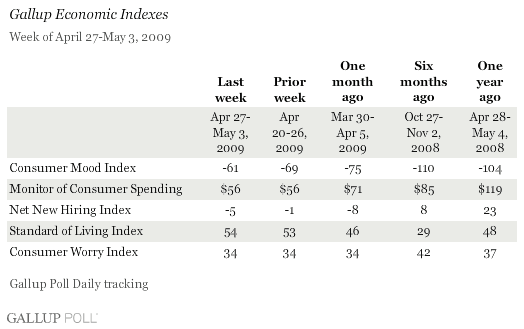
(Maximum possible value of 200; minimum possible value of -200)
The Ë┼├█┤ź├ŻConsumer Mood Index improved to -61 last week, almost erasing the previous week's pullback to -69 and approaching the -57 for the week ending April 19 -- which was the Index's best level in over a year. The Index has improved from -75 a month ago and -104 a year ago. While this indicates that consumers as a whole remain negative about the U.S. economy and its future direction, the overall trend has been one of improvement over the past two months, with attitudes leveling off during the past few weeks.
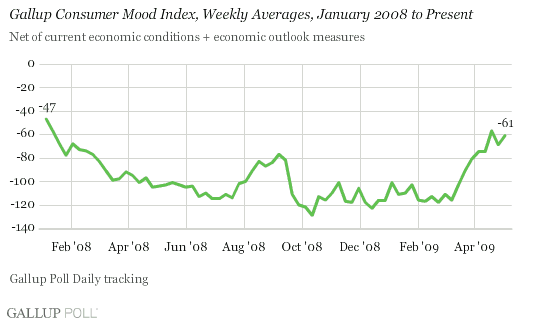
The Consumer Mood Index is based on Americans' answers to two questions -- one asking about current economic conditions in the country and the other about the direction of the economy. Consumers' negativity has diminished significantly on both dimensions compared with early March; however, this has been most pronounced with respect to the economy's direction.
Consumer perceptions that the economy is getting worse rather than better moderated from a net -59 in early March to a net -24 this past week. Consumer perceptions of current economic conditions remain much more negative than positive, with only 11% calling them "excellent" or "good" versus 48% rating them "poor," resulting in a net current conditions score of -37. This is essentially the same as the -38 of the week ending April 19.
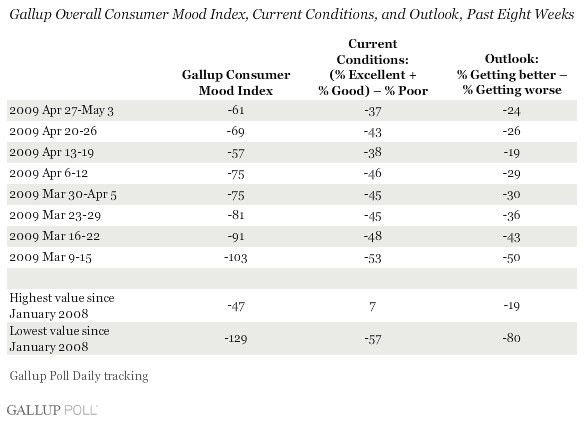
(Unlimited maximum possible value; minimum possible value of $0)
For the second week in a row, Americans reported spending an average of $56 per day in stores, restaurants, gas stations, and online. Average spending was $71 a month ago and $119 for the same week a year ago, so last week's spending is down 53% from a year ago -- even worse than the 43% year-to-year decline of the prior week. Adjusting for seasonal effects by using year-ago comparables suggests consumer spending is falling further behind year-ago levels even as the overall consumer mood has improved. (Gallup's spending data are based on Americans' self-reports of the total amount of money they spent the prior day on purchases other than a home, a motor vehicle, or their normal monthly bills.)
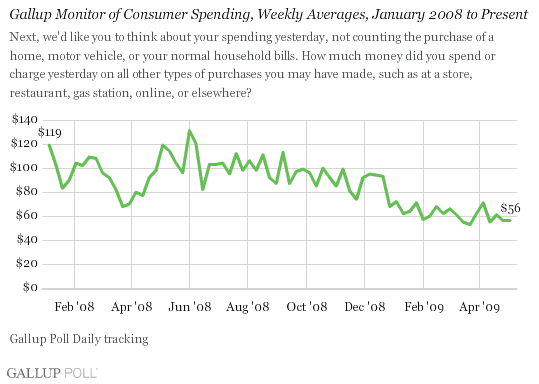
(Maximum possible value of 100; minimum possible value of -100)
In recent weeks, employees' reports on hiring and firing patterns at their own workplaces have shown substantial improvement, but that was not the case last week. Gallup's Net New Hiring Index was -5 for the week ending May 3 -- worse than the -1 of the prior two weeks, but an improvement from the -11 of the week ending April 12 (which remains the worst reading since tracking began in January 2008). From a longer-term perspective, net new hiring was in positive territory for most of 2008; the Index was at 23 a year ago. It fell below zero for the first time in mid-December and has been in negative territory every week since.
Last week's Index score of -5 is based on the finding that 22% of full- and part-time employees said their employers were hiring people and expanding the number of employees in their workforces while 27% reported their companies were letting people go.
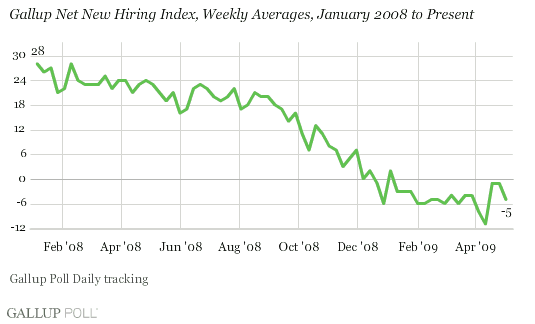
(Maximum possible value of 200; minimum possible value of -200)
The Ë┼├█┤ź├ŻStandard of Living Index was at 54 last week, essentially the same as the previous week's 53. The Index remains higher than it was a month ago (46) as well as a year ago (48).
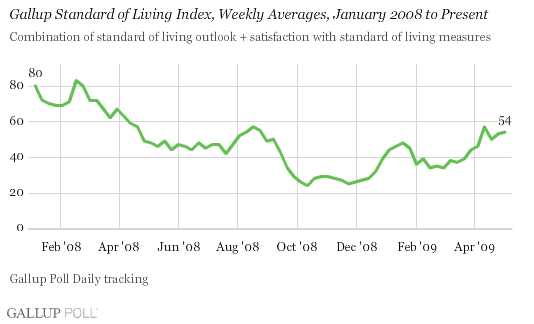
Gallup's Standard of Living Index is based on two questions -- one asking about respondents' satisfaction with their current standard of living and the other about the perceived direction of their standard of living. This past week, more consumers once again said their standard of living is getting better (41%) than said it is getting worse (36%). At the same time, 74% of consumers said they were satisfied with their standard of living and 25% were dissatisfied, virtually the same as the previous week's results.
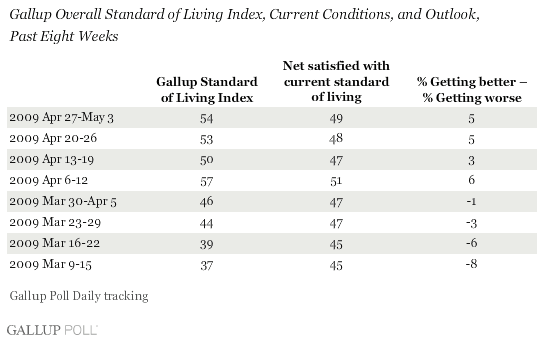
(Maximum possible value of 100; minimum possible value of 0)
The Ë┼├█┤ź├ŻConsumer Worry Index is at 34 for the week ending May 3 -- the same as the readings for the previous several weeks but slightly below the 37 of a year ago.
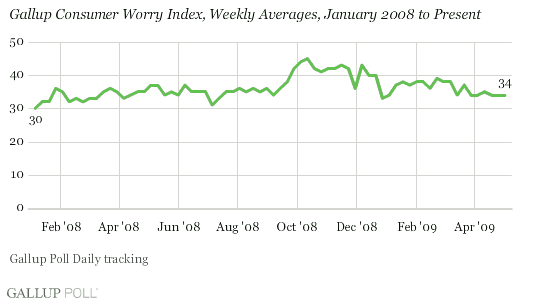
Commentary
It is hard not to be enthusiastic about the direction of the economy when the equities market had its best April since 1938 and continues to push ahead in early May. This sharp improvement and the gain in wealth it reflects help explain how Americans have become less pessimistic about the U.S. economy over the past couple of months. The emerging market consensus seems to be that the economy is no longer in free-fall and may be bottoming out.
Still, Gallup's detailed daily and weekly tracking of consumer perceptions suggests that it may be premature to celebrate and that today's markets could be experiencing some of that old "irrational exuberance." Most worrisome in this regard is consumer spending -- flat in recent weeks but down more than 50% from a year ago -- and its failure to keep up with last year's comparables. This is not good news for the many retailers and small businesses currently struggling to survive. Further, it suggests that although consumers are feeling less pessimistic, they do not feel secure enough to spend on even a daily basis, let alone on such things as cars and homes.
Add to this spending concern the continued weakness in the jobs market that will not be improved by ; take into consideration the bank "stress tests" and what they might say about ; and note the , and it is easy to see that consumer perceptions on Main Street may be diverging from the seeming euphoria on Wall Street.
As noted previously, until the decline in consumer spending comes to a halt, no one should assume that the economic downturn has leveled off -- let alone that a recovery has begun. And it may require a significant improvement in business "visibility" and job creation before consumers as a whole feel comfortable spending once again -- .
Survey Methods
For Ë┼├█┤ź├ŻPoll Daily tracking, Ë┼├█┤ź├Żinterviews approximately 1,000 national adults, aged 18 and older, each day. Gallup's consumer series includes the Ë┼├█┤ź├ŻConsumer Mood Index (evaluating public perceptions about the U.S. economy), the Ë┼├█┤ź├ŻMonitor of Consumer Spending (a measure of how much money Americans are spending each day on mainly retail purchases), the Ë┼├█┤ź├ŻNet New Hiring Index (a measure of employee perceptions of hiring conditions where they work), the Ë┼├█┤ź├ŻStandard of Living Index (evaluating the public's perceptions about its own standard of living), and the Ë┼├█┤ź├ŻConsumer Worry Index (a measure of the degree to which Americans are worried about their finances).
The Standard of Living Index is based on questions asked of all respondents; the Ë┼├█┤ź├ŻConsumer Mood Index, the Ë┼├█┤ź├ŻMonitor of Consumer Spending, and the Ë┼├█┤ź├ŻConsumer Worry Index are based on random half-samples of approximately 500 national adults, aged 18 and older, each day. The Ë┼├█┤ź├ŻNet New Hiring Index is based on a sample of approximately 250 current full- and part-time employees each day.
The sample sizes and associated margins of error for weekly results for the week of April 27-May 3 are:

Interviews are conducted with respondents on land-line telephones (for respondents with a land-line telephone) and cellular phones (for respondents who are cell-phone only).
In addition to sampling error, question wording and practical difficulties in conducting surveys can introduce error or bias into the findings of public opinion polls.
